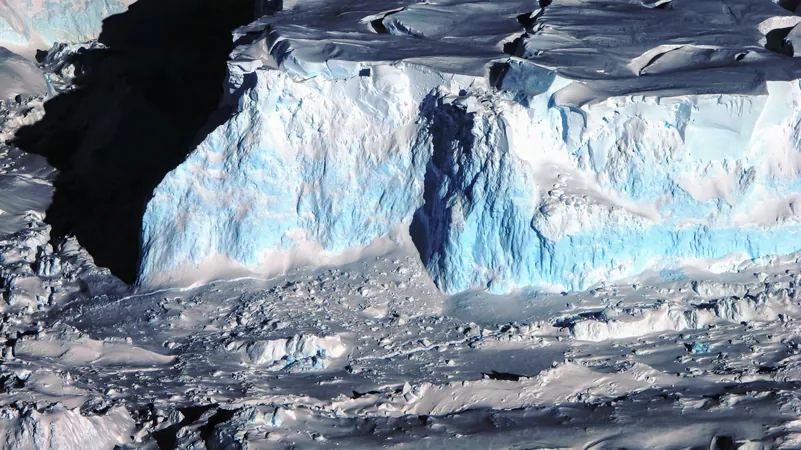
The Grim Reality of the Doomsday Glacier: Thwaites Could Collapse Soon!
2024-09-22
In the frigid and isolated regions of Antarctica, a catastrophic phenomenon is unfolding—one that could have dire consequences for our planet. The Thwaites Glacier, ominously dubbed the "Doomsday Glacier," is now exhibiting alarming signs of instability, with researchers warning that its collapse may occur much sooner than previously anticipated.
Accelerated Retreat of Thwaites
The findings from ongoing investigations have been unsettling. Not only is the Thwaites Glacier in retreat, but it is reportedly accelerating at an unprecedented pace—a trend that is expected to worsen in the coming years. Rob Larter, a marine geophysicist at the British Antarctic Survey and a key member of the ITGC team, highlighted that Thwaites has been receding for over 80 years, with significant acceleration occurring during the past three decades. Dr. Larter ominously stated that “the glacier is set to retreat further and faster.”
Potential Global Catastrophe
What makes the situation even more alarming is the prospect of Thwaites causing a catastrophic rise in sea levels. Current predictions suggest that the complete collapse of Thwaites and the Antarctic Ice Sheet could happen within the next two centuries, releasing enough water to raise global sea levels by over two feet. If this glacier fails, the consequences would be far-reaching, with cities like Miami, London, and populous regions in Bangladesh facing the threat of submersion.
Furthermore, Thwaites plays a critical role in holding back the larger Antarctic Ice Sheet, much like a cork in a bottle. Should it collapse, scientists warn that sea levels could rise by an astonishing ten feet, with implications that extend far beyond coastal cities.
Examining the Glacier’s Grounding Line
The ITGC’s research included sending Icefin, an innovative underwater robot, to examine the grounding line of Thwaites, the precarious juncture between where the glacier rests on the seabed and where it starts floating. The first glimpse of this grounding line was described by glaciologist Kiya Riverman as a defining moment comparable to the emotions felt during the moon landing.
Images captured by Icefin have shed light on the alarming mechanisms behind the glacier's melting. Researchers discovered that warm ocean water is infiltrating deep crevices, allowing it to erode the ice from below. Additional findings indicated that seawater can penetrate over six miles beneath the glacier, fueling rapid melting that endangers its stability.
Historical Context and Future Predictions
The study of marine sediment cores has unveiled that Thwaites began its rapid retreat as early as the 1940s, likely spurred by a powerful El Niño event. Despite some positive signs—computer simulations suggesting lower risks of ice shelf collapses than once feared—the future of Thwaites remains perilous. With predictions hinting at a potential disappearance of Thwaites and the associated ice sheet by the 23rd century, specialists emphasize the urgent need for climate action.
A Global Call to Action Against Climate Change
The unfolding narrative of the Thwaites Glacier highlights the critical need for a united global response to climate change. Collaborative efforts like the ITGC are vital for harnessing international expertise and resources to combat rising sea levels. Scientists from various fields—oceanography, geology, and climate science—are pooling their knowledge to devise strategies that could mitigate the impact of climate change.
Moreover, while Thwaites commands attention due to its significant potential to influence global sea levels, researchers are also turning their sights on other vulnerable regions of Antarctica. Understanding how different glaciers interact with warmer ocean waters is essential for developing accurate models of future scenarios and informing climate adaptation strategies for coastal cities worldwide.
Uncertain Future Ahead
As the ITGC moves forward with its crucial research, scientists acknowledge the deep uncertainty surrounding Thwaites' future. Glaciologist Eric Rignot from the University of California, Irvine, expressed concern over the current state of this sector of Antarctica, remarking, "I remain very worried that this sector is already in a state of collapse."
Ultimately, the fate of Thwaites serves as a critical reminder that time is running out to address the climate crisis. With profound implications for millions of lives across the globe, the world must act swiftly to protect our planet from impending doom.

 Brasil (PT)
Brasil (PT)
 Canada (EN)
Canada (EN)
 Chile (ES)
Chile (ES)
 España (ES)
España (ES)
 France (FR)
France (FR)
 Hong Kong (EN)
Hong Kong (EN)
 Italia (IT)
Italia (IT)
 日本 (JA)
日本 (JA)
 Magyarország (HU)
Magyarország (HU)
 Norge (NO)
Norge (NO)
 Polska (PL)
Polska (PL)
 Schweiz (DE)
Schweiz (DE)
 Singapore (EN)
Singapore (EN)
 Sverige (SV)
Sverige (SV)
 Suomi (FI)
Suomi (FI)
 Türkiye (TR)
Türkiye (TR)